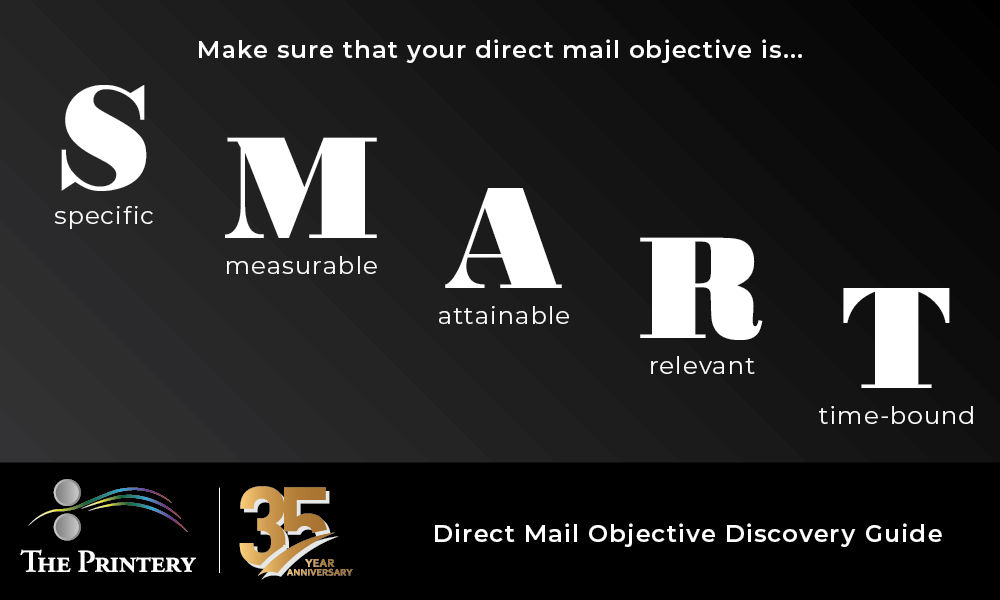In this article we have created a list of our recommended 10 steps to create successful direct mail campaigns. Direct mail remains one of the most effective ways to reach your audience, particularly when integrated with digital marketing strategies. With the U.S. Postal Service (USPS) providing resources and support, creating a successful direct mail campaign is more achievable than ever. This guide outlines the 10 essential steps to help you develop a direct mail campaign that drives results.
1. Define Your Campaign Goals
Before launching a direct mail campaign, it is crucial to define clear objectives. What do you want to achieve? Whether it’s increasing brand awareness, generating leads, or driving sales, your goals should be specific, measurable, attainable, relevant, and time-bound (SMART). Clear goals not only guide the campaign’s direction but also make it easier to evaluate its success later on.
For example, a goal might be to increase store visits by 20% over the next three months or to generate 500 new leads within a certain timeframe. By having defined targets, you can tailor your messaging and design to align with these objectives.

2. Identify and Segment Your Target Audience
Understanding who you want to reach is the cornerstone of a successful direct mail campaign. Start by identifying your ideal customer. Who are they? What are their needs, preferences, and behaviors? The more you know about your audience, the better you can tailor your message to resonate with them.
Segmentation is also vital. Divide your audience into specific groups based on factors like demographics, purchase history, or geographic location. For instance, you might have one segment for existing customers and another for prospects. By personalizing your message to each segment, you increase the relevance and effectiveness of your campaign.
3. Craft a Compelling Offer
Your offer is what drives recipients to take action. It needs to be compelling, clear, and aligned with your campaign goals. Whether you’re offering a discount, a free trial, or exclusive content, the offer should be something that your audience finds valuable.
When crafting your offer, consider what will resonate most with your target audience. For example, a time-limited discount may create a sense of urgency, encouraging quick action. Additionally, ensure that the offer is easy to understand and directly tied to the call-to-action (CTA).
4. Develop a Strong Message
Your message is the heart of your direct mail campaign. It should clearly communicate the value of your offer and guide the recipient towards taking action. A strong message is concise, benefits-oriented, and aligns with your brand voice.
Focus on the benefits to the recipient rather than just the features of your product or service. Use persuasive language that speaks directly to the needs and desires of your audience. For example, instead of saying, “Our software has multiple features,” say, “Our software simplifies your workflow, saving you time and effort.”
5. Design Eye-Catching Mail Pieces
The design of your mail piece is the first thing your audience will notice, so it needs to stand out. Use a clean, professional design that reflects your brand. The design should also be aligned with the message and the offer, enhancing the overall effectiveness of the campaign.
Key design elements include the use of high-quality images, consistent brand colors, and a clear hierarchy of information. Ensure that the CTA is prominent and easy to find. Additionally, consider using unique formats, like oversized postcards or dimensional mail, to catch the recipient’s attention.
6. Choose the Right Mail Format
Selecting the appropriate mail format is crucial for delivering your message effectively. USPS offers various formats, including postcards, letters, self-mailers, and catalogs, each suited to different types of campaigns. To learn more about USPS Direct Mail Basics, click here.
For example, postcards are cost-effective and great for short messages and promotions. Letters offer more space for detailed messaging and personalization, while catalogs allow you to showcase multiple products. Choose the format that best aligns with your campaign goals and content.
7. Personalize Your Campaign
Personalization can significantly increase the effectiveness of your direct mail campaign. Use the recipient’s name, customize the content based on their interests or past interactions, and tailor the message to address their specific needs.
Variable data printing allows you to personalize different elements of the mail piece, from the salutation to the images shown. This level of personalization helps create a stronger connection with the recipient, making them more likely to engage with your message.
8. Plan Your Mailing Schedule
Timing is everything in direct mail campaigns. Plan your mailing schedule based on your campaign goals and the behavior of your target audience. For example, if you’re promoting a seasonal sale, ensure that the mail pieces arrive well before the sale begins.
Also, consider the frequency of your mailings. While a single mailing might not be enough to drive action, a series of mailings can reinforce your message and keep your brand top of mind.
9. Track and Measure Results
To determine the success of your direct mail campaign, tracking and measuring the results is essential. Use unique tracking codes, personalized URLs (PURLs), or QR codes to monitor responses. This data will help you understand which elements of your campaign were most effective.
Analyze metrics such as response rates, conversion rates, and return on investment (ROI). These insights will inform future campaigns, helping you refine your strategy and achieve better results.
10. Optimize for Future Campaigns
No campaign is perfect the first time, so use the insights gained from tracking and measuring to optimize future campaigns. Test different elements, such as the design, offer, or messaging, to see what resonates best with your audience.
Final thought on 10 Steps to create successful direct mail campaigns
Continuous optimization is key to improving the effectiveness of your direct mail campaigns over time. By regularly refining your approach, you can increase response rates, boost conversions, and achieve your marketing goals more efficiently.
If you would like to learn more about our direct mail services, visit our Direct Mail Page:
If you are interested in our help, or would like to receive a quote for your next direct mail campaign, click “Get Printing” below to get started today:




